Perhaps you’ve had an interest in bonsai for a while now and you’ve finally given in to the urge and bought yourself a “bonsai” (or maybe you’ve received a gift) and now you’ve gone on the Internet and started doing research to keep it alive and suddenly, you find that you haven’t actually purchased a “bonsai” but this repugnant and malicious thing people sneeringly call a “mallsai”.
And you’ve probably gotten yourself a little juniper because that’s what most people think of when they think “bonsai”. (If you got a ginseng ficus this post is the one for you).
I’ve actually had a lady come to the nursery and I showed her all kinds of trees, elm, oak, ficus, tamarind…and she says “You keep showing me all these little trees in pots. Where are all the bonsai?”
Anyway…..
When you started searching you found that the forum participants are a bit mean (they don’t really mean to be but they’ve seen hundreds of these little trees and are just a little weary of the same questions, problems and, seemingly, the same looking tree).
You’re going to have all kinds of advice; repot it, water from the top, bottom, once a week, once a day, mist it hourly, etc. etc. etc……
This is the straight dope!
Pay attention.
First, if it’s a juniper, it needs to be outside.
Outside.
Regardless of what you see on tv shows, in decorating magazines or whereever, a juniper is an outdoor tree (unless you want to spend several hundred dollars on the best grow lights you can buy with a special grow box and a humidity control device etc.)
In fact, most plants can only tolerate being indoors for any length of time, even those plants grown as houseplants, never mind bonsai trees.
The question you’re asking now is: but it’s freezing now, how can it live if the roots freeze in the pot?
Or: it’s summer now and the sun will burn it!
Junipers are pretty shallow rooted and if it’s cold enough for the ground to freeze and the junipers are planted in the ground……just saying. And as far as the sun, they grow in the desert for crying out loud.
This is what you do if you’re concerned.
Start with the tree on the window sill, then place it just outside the door, then under a tree….. you’re goal is to get it acclimated slowly into (out to?) living outside.
If you are still afraid, many people build a cold frame for their bonsai in the winter and a little shade house in the summer to pamper them a little (use the googles machine to find a plan that best suites you).
On to watering:
There is no schedule when watering a tree. Sorry, you can’t mark your calendar, tell Siri to remind you or only water on Tuesdays or the third day and twice every sixth fifthday.
It needs to be watered when it needs it. Period.
The watering frequency will depend on your dirt.
Actually, it’s not really dirt.
We call it soil, but it’s not really soil (soil being a fancy name for dirt). In fact, that bag at the gardening center labeled potting “soil” isn’t even soil.
Technically it’s called “soilless mix”.
Anyway, if you have the dreaded “mallsai” it is probably planted in regular potting soil (Ok, soilless mix- which is either a mix of peat, sand, and perlite or pine bark, sand and perlite. Although many mixes don’t use perlite much any more, it’s too expensive. Which totally redefines the term “dirt cheap”, right?) with little pebbles glued on top.
At this point in the narrative you must find a hammer and chisel and bust your tree free from the rocky prison encapsulating its roots.
I know the glued on rocks look pretty but they must be removed. Now, some people will tell you it’s because water can’t penetrate to the roots (which is incorrect) or that the rocks suffocate the roots (again, incorrect); the only reason to remove the rocks is because you can’t tell how wet/dry the soil is.
And that is how you tell when the soil is ready. By putting your finger in it.
Which is a life lesson: the only way to tell sometimes if something is ready is to stick your finger inside to feel how wet it is.
Ahem.
Water when the soil is dry about 3/5th to about 7/13th of an inch down, depending on the pot depth. Make sure to use a ruler or a some type of depth gauge device to be accurate.
Going back to the soil, you’ll have admonitions and exhortations that unless you change your soil ASAP your tree will die.
Nope.
Leave it be until it needs to be changed.
That’s easy for me to say, right?
Don’t worry, it will be about a year, or more, before you need to change it out.
My first tree (also a procumbens nana juniper I got at Sam’s Club) lasted about 3 years in the same soil.
But it did die because I didn’t repot it. The soil had broken down and the tree had become root bound because I left it too long.
So, yes, for the record, I did kill my first tree but….(BUT!) how many people do you know that can say they have a cutting off their first tree that is now a well established bonsai itself? HUH?

I, coincidentally, just repotted it.
It needs some wire and refinement now, but that’s another post yet to be written.
I tell you not to worry about soil for at least a year because it’s entirely possible that the tree you now have was just put into this container.
Let the roots grow before you bother them again.
Junipers grow in worse conditions than this pot and (most likely) the crappy soil it’s in.
Now to the feeding.
The basics:
First, it’s not feeding, it’s fertilizing.
The tree feeds itself using photosynthesis.
What we do when we fertilize is more akin to taking vitamins.
Second, there are two different methods of fertilizing.
Liquid and granular.
Liquid fertilizer is broken down into organic (they usually call the organic preparations “teas”. Worm tea, seaweed tea, fish emulsion tea) and inorganic (like Miracle Grow or many of the so-called “bonsai” fertilizers).
I won’t argue here the benefits and detriments of both kinds (and there is reason to use one or the other at certain times) but they share the same technique of application.
It is to be sprayed primarily on the foliage. You can water it in but the whole idea is for the plant to take in the fertilizer through the leaves.
Liquid fertilizer must also be applied quite frequently because it is pretty much gone after the first spraying.
And follow the label directions; they are not arbitrary, the company has to spend a lot of money testing the product to comply with Federal regulations and the application rate they’ve come up with is correct.
you do not need to cut to half strength!
I cringe whenever I read that. You might as well not even bother.
A plant is a plant whether it’s a bonsai or a philodendron.
Follow label instructions.
Granular fertilizer:
There are also organic and inorganic kinds but the main difference with granular is whether it is time release or not.
Time release means that there is a special coating or capsule containing the fertilizer and that, if certain parameters are met (those parameters are different with each brand) the fertilizer will apply itself with each watering.
The non time release granular fertilizers are “time release” by their nature (the grain erodes with each watering) but they are not technically “time release” as they are usually used up within a few waterings.
My advice, avoid the liquid fertilizing and just get a good time release granular product.
When you have more experience you can start to tailor your regimen to your particular situation.
So, now I’ve relieved some of your anxiety about care but people are still calling your tree a “stupid little cutting in a bonsai pot, it’s not a real bonsai” or, “even though technically a bonsai is just a tree in a pot, it’s more than that, duh!”
Let’s clear some things up.
Most junipers, unless collected from the wild (not someone’s yard) or part of a breeding program, are cuttings.
That is simply how they’re propagated.
And if we use the second criteria, that there should be a degree of artistic shaping done to the tree, the question is then begged, how much?
That’s a tough task, drawing the line, isn’t it?
I might think that a tree I’ve been laboriously working on for seven years is a bonsai but Joe Blow fresh from Japan might think otherwise.
A word to the “mallsai” dismissers- judge not, lest ye be judged.
How about some education instead of dismissal.
It’s best to explain some techniques and aesthetics instead of just saying “it ain’t a bone-sigh. ”
Oh, that’s how the Japanese word is pronounce by the way. Bone-sigh, not bahn-zai.
So what is a bonsai supposed to be then?
It is a tree in a pot.
The whole idea, though, is to make a little, relatively young tree, look like a big, old tree.
And that’s why those people sneer at your new little bonsai and call it a mallsai.
It was mass produced for market with little artistic shaping or consideration.
So what now?
That’s what this whole post is; a buildup to some aesthetic techniques that will hopefully help you’re little tree look older and more…bonsai-ish.
We all have to start somewhere.
I don’t suggest you try this until you’ve kept the tree alive for at least half a year.
Let’s begin, ok?
This is not technically a mallsai as I took the cutting myself but it’s close enough:

One maxim you will hear if you keep on the path to bonsai-zen enlightenment is the saying that “a juniper is not mature unless it has some deadwood on it”.
Obviously, if our intent is to make a tree look old, deadwood will help, correct?

Another visual cue to make a tree look old is to make the branches twisty and gnarly.
A little wire:
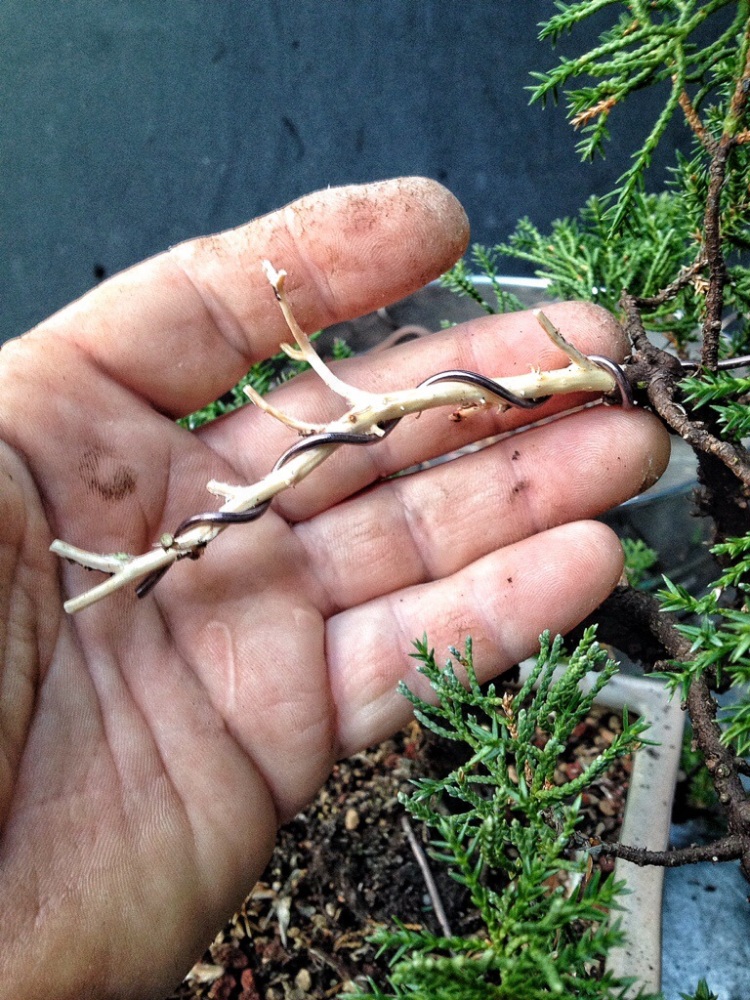
A little twist:
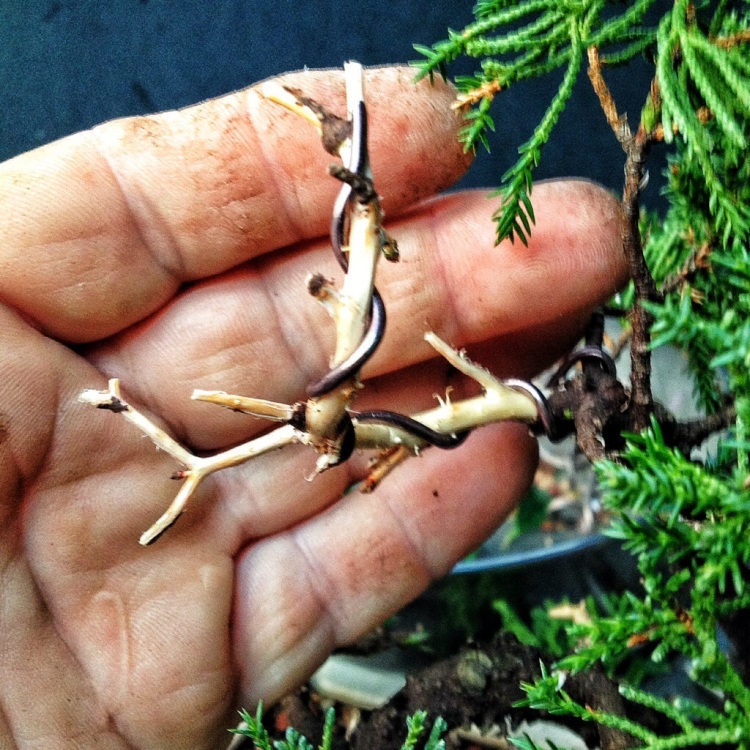
Continuing on with the idea of curves, the trunk, even though it doubles back on itself, is still a little straight in places:
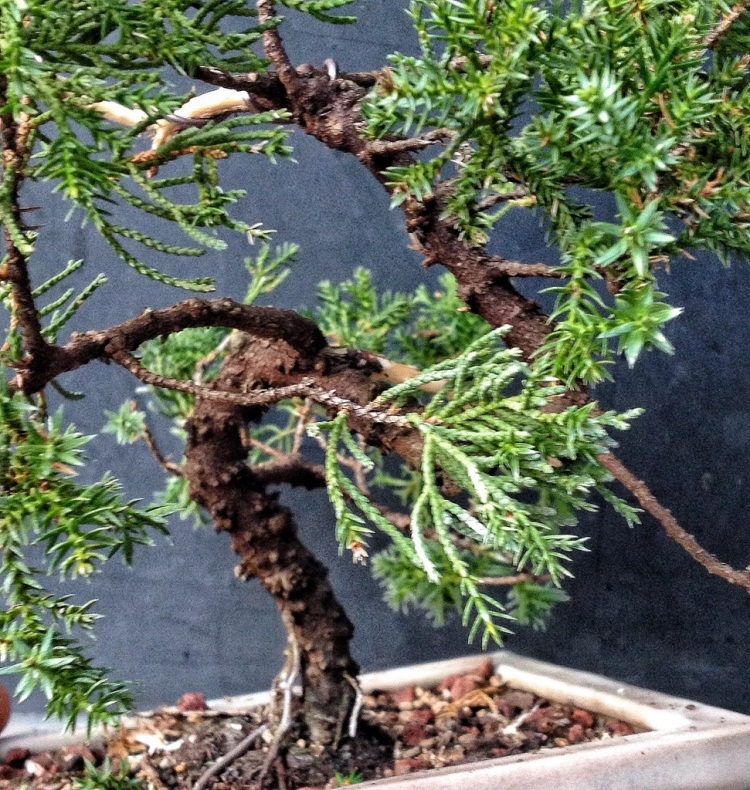
Some wire and bending:

Some wire on the branches:

I should talk about the branches a bit before I finish.
You will read in many beginner instructions about the “number one branch, number two branch, back branch” approach to the artistic styling of a bonsai tree.
All I have to say to that is, meh.
It works but then you end up having little cookie cutter trees and every one of them is mediocre.
Use the branches you have, and try to make the tree three dimensional.
This was the tree before:

And now:
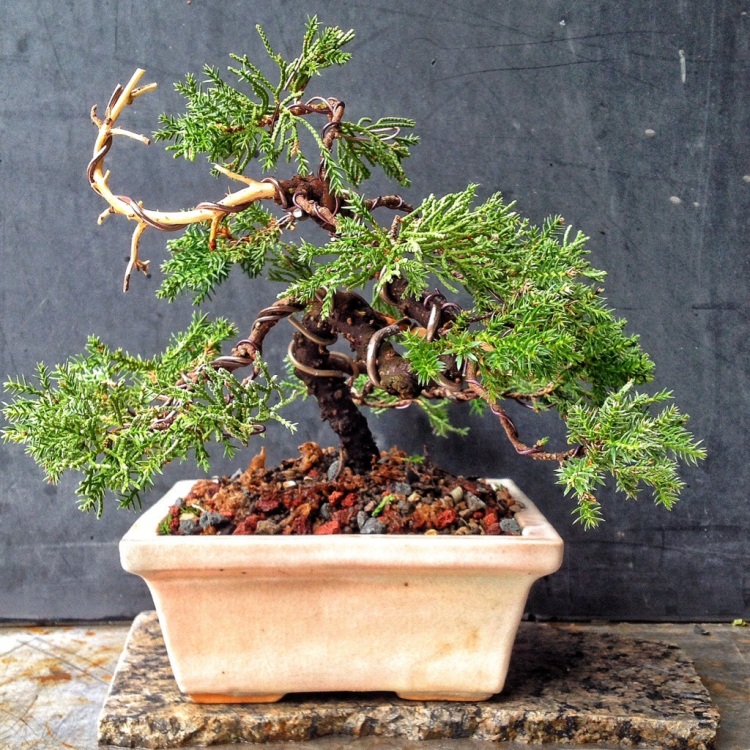
It is often beneficial to sketch a future direction for your tree in order to help you to see what you want it to grow into.
Here is my sketch:
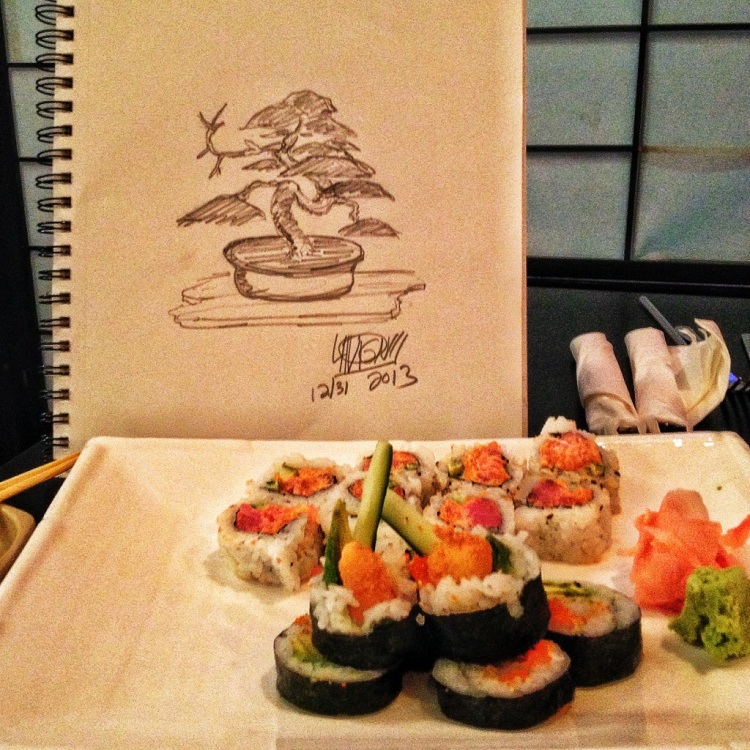
It was also my New Years Eve dinner- Sushi at Lai Lai’s Chinese Cuisine and Sushi Bar in Orlando. My recommendation for sushi if you’re in town.
I’m hoping this helped a little; feel free to comment and ask questions, if I don’t know the answer I’ll make something up, I’m good at that.
- Comment
- Reblog
-
Subscribe
Subscribed
Already have a WordPress.com account? Log in now.
I didn’t get a mallsai, but I did ask questions when my Tea Tree turned out to be smaller than I anticipated! (It’s doing well, btw, which makes me happy!)
I’ve been working on getting cuttings from the mulberries to root, not much success there yet, but I’ll try again in spring.
You’ve been fantastic about answering dumb questions for me and it is much appreciated. If someone is reading and has questions but is hesitating because of bad reactions elsewhere, do ask. Adam is the bomb!
LikeLike
Thanks Farmgirl! Go check out her blog: http://tractortracks.blogspot.com/?m=0
LikeLike
Mine is…. not all that interesting to the bonsai crowd, probably. But thanks for the plug anyway, and I’m sort of surprised you remembered I had one LOL.
LikeLike
Thank you for good advice. I have been learning a lot between bonsai and niwaki pruning. Would you say bonsai is niwaki in a pot? I have worked on pines that have been/being shaped using ties and guy lines and bamboo poles on the branches, etc.. to train branches, but in bonsai, I have a question as to why they use wire? Also. I know that junipers and pines are more flexible to bend and train to shapes but, what about deciduous trees, for ex. I have a little seedling Katsura Cercidiphyllum japonicum tree that I am thinking about going full bonsai on and is this type of tree conducive to bonsai? Its already had it’s last summers leaves that were really small! Thank you!
LikeLike
I’ve not studied niwaki techniques (how Japanese gardeners prune trees) and, though the end result is similar, from what I’ve read, the techniques are slightly to drastically different.
We use wire because it is a cleaner look when applied and finer detail can be achieved (i.e. Tighter bends, more drastic angles).
We do use shaping techniques on deciduous trees.
I’m not familiar with the Katsura but there are some examples on the Internet Bonsai Club forums and from what I read it’s more of an intermediate level tree.
It also looks like you should grow it large before you try to shape it.
Don’t let it discourage you from trying though.
LikeLike
Well done. Half-strength fertilizer applications do have merit though; a month or so after repotting a tree is one IMO.
LikeLike
Great read, I cant wait to shape my mall sigh…. into a Bone-sigh! Hahaha people get so uptight over the hobbies and things they grow affection for.
I can see myself in a few years saying, “what was I thinking buying a cheap bonsai from Lowe’s? But, I suppose it makes for a good starter.
LikeLike
Foliar feeding? I thought that was mainly for the micro nutrients not for the big 3…….guess you can figure out i’m getting ready to repot a little procubens and thought I should check in with my sensei..
LikeLike
So after discovering that the unfortunate plant I ran across at Sams the other day has an actual term, I was happy to find this particular post. Out of order for my reading, it did answer a few questions about whether or not to go back and rescue one of those unfortunate Juniper… (still on the fence about that). When looking at the drawing, the shape of your (yes I know it is not..now anyway) “apices” of your plan, it is different from the actual top branch of the tree. Is that because you are hoping to use that other back branch for taper? Again, I feel like I may be finally starting to see the things you have been talking about in all your posts.
LikeLike
Usually with a juniper you position the branches to build the canopy. Taper on one isn’t that important. What’s more important is the line and movement. Junipers are the most abstracted bonsai
LikeLike
Just received a Pro-Nana juniper as a gift. It is January in Montreal with more than a foot of snow, frozen ground and temperatures fluctuating from +2C to -22C; freezing rain some days.
Reading about keeping the plant outdoors and needing a period of dormancy – how can you tell when it is dormant and what do we do with this plant in mid-winter?
Confused.
Rae
LikeLike
You will need to find out where the plant was being help before you got it. Dormancy for a conifer really means it’s not growing actively, they don’t really do dormant. For you now that means maybe putting it in an unheated garage or making a cold frame (google it but basically make a small “building”, as big as it is, and piling snow on top)
You just want to keep the soil temps below about 10c (50f) but above sub freezing. A cold frame acts like an igloo and the unheated garage the same.
Hope that helps, what you should do is find a local club or group and pick their brains with how they handle it.
I will say, the whole dormancy thing with junipers isn’t written in stone. I grow the same plant and we get maybe one or two days of freezing temps a year. Think about that.
LikeLike
Reblogged this on Wolf's Birding and Bonsai Blog.
LikeLike